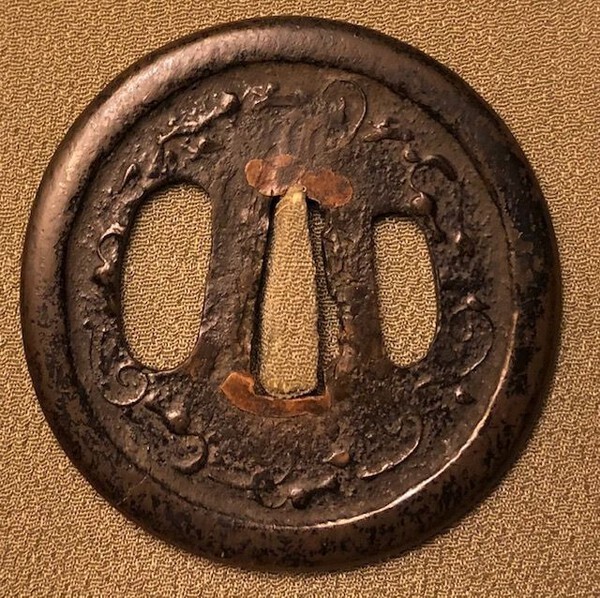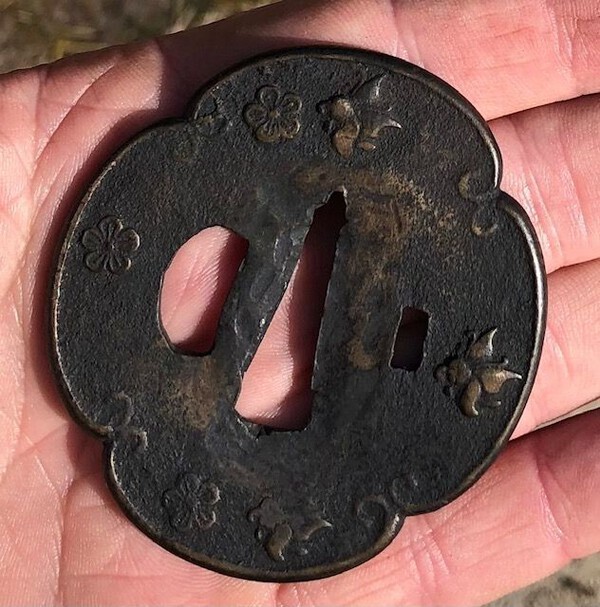-
Posts
290 -
Joined
-
Last visited
Content Type
Profiles
Forums
Events
Store
Downloads
Gallery
Everything posted by johnnyi
-
Curran, Thank you for bringing this to my attention! Slippin' in my old age. Dimensions are 7.4 cm x 7.6 cm x 0.75 cm
-
Bold design and excellent iron. The quintessential Sado Island tsuba, Provenance Robert Haynes. It can best be described by Robert Haynes himself, with quote borrowed from Elliott Long's excellent site and resource, "Shibui Swords". $650 shipped
-
Gentlemen, thank you for your helpful replies. I think the Kyo-shoami seems most likely, as the scoring on the edges of the wings and the cross hatching of the beaks and bodies for nunome seem contemporary (but who knows). As well, after looking at mimi's of ko-shoami, they seem more half rounded, not quite the same as this tsuba which has a more abrupt edge.. The tsuba does look rustic, with breaks in the iron and laminations, but maybe it was made in a more rural shop as Florian suggests. Steve, regarding folding, please give me a few days and I'll take pictures of different type folds and send them on. Thank you again everyone for your input, John. .
-
Hello all. Hopefully someone more knowledgeable than I can tell me what school this tsuba hails from? The iron is fudge-like. Under magnification it contains pyrite crystals, consistent with old iron. Tsuba is 79.8 high and 80.0 wide. 5.7mm thick mimi and slightly less (5.5mm) seppa dai. There is visible folding and subtle iron bones on rim. I was thinking ko-shoami, but did they use gold leaf?? Here are a couple pictures; second one showing odd placement of birds and clearer shot of gilding of feathers and beaks. Thanks in advance for your help, John I.
-
Second tsuba (with round hitsu ana) is sold
-
-
The first is an ex-Doffin tsuba from several years ago which I've been unable to identify. (Checking out Grey's site may turn up more detailed pictures than I can provide, as well as provide fun window shopping) This tsuba is forged and layered and well patinated. It is skillfully carved, both with chisel and possibly with acid?. It' foliage is highlighted with subtle specks of gold. There is no evidence that it's rim was ever silvered, and tsuba appears unaltered. As Grey states, the more you look at it the more interesting it becomes. It is large, measuring 82 mm by 81.6 mm. Seppa is 4.1 mm , surface is 2.8 mm, and raised rim is 3.4 mm thick. $290 plus shipping The second tsuba (ex-Kolecki) is also a mystery to me. It has a beautiful feel to the iron, and has deep patination. It has been altered, in that there seem to be petals which have been stamped over with another crest. Other areas seem to show intentional obscuring of design. The pads on the large hitsu-ana seem to show one has been replaced, and there is another area of brass or copper just below a pad which sems to have been added also long ago. This tsuba is something special but I don't know what. Hopefully you do. 7.4 mm 3.5 mm thick $200 plus shipping
-
This is a small tosho tsuba with depiction of a daikon or possibly clove in sukashi. Nice patina. Dimensions are 77.1 mm tall 76.7 wide 2.4 mm thick at seppa 2.7- 2.8 at rim. Shape of hitsu-ana suggest momoyama.. $275 plus shipping
- 1 reply
-
- 1
-

-
Tosho tsuba, The small round hitsu are consistent with early Muromachi or perhaps earlier. The paper simply says "Tosho". The iron is finely worked; easy to get lost in, The surfaces show a subtle design of rain; more pronounced on the ura, also consistent with an older piece. Height is 91.6 mm. Width 91.4 mm, Thickness 2.1. mm at seppa dai, 1.7 mm at rim. An outstanding piece demonstrating the finest in skill and execution. $600 plus shipping (with portion going to Brian)
-
Nice buy Dale. I was inspired by Richard's post also, and I sent away for a bargain basement used zoom, but no screen unfortunately. I have sent away for a camera which I am hoping will mount in one of the two tubes. I'm finding it easy now to see folded over rims as opposed to carved out rims on some of the old iron. Power is 40x at highest, but that seems enough. Have fun with yours! regards, John
-
Dale, there might be three problem areas, as it seems that there seems to be a crack that extends through the seppa dai and is visible on both sides. regards, John
-
A very long shot, but twelve links are a more obscure Buddhist symbol which sometimes relates to interconnectivity. John
-
Beautiful tsuba. Although the "fruit" bears a resemblance to what we often assume are either daikon or cloives, the vines might suggest newly formed gourds also, not unlike those on this very old kagami-shi. regards, John
-
The knot work is humble but lovely. Reminds me of the old timer's sea bags I'd see in the service years ago that were covered with the most ornate knotwork, and crown knots similar to what this has. Maybe a sailor's property?
-
Fruit or blossom on a branch does seem to be what it is. (Thanks again Thomas and Dale).
-
Here's the face. The insect and plum (?) blossom lend some weight to your idea of a fruit on the verso, but why the hole/doughnut shape on a fruit? It wouldn't be settling of the casting, because it seems consistent on all four, right?
-
Thanks Thomas. Trouble with worn theory is that element is identical in all four impressions. It is a toughy for sure, and probably something so obvious that we can't see it.
-
Thanks Dale. I had completely forgotten about the wonderful "Tsuba Kansho" by Jim Gilbert. Thank you! Still at a loss to what the image is though. The circle confounds most of my guesses. Best, John I
-
I'm having a time trying to identify this decoration on kagami-shi tsuba. The circle is confounding me. Could this be Shinto or Buddhist rope, and something else combined? I thought squirrel at first, but they don't have donut bodies. Any ideas please? Thanks, John I
-
I just hope my wife doesn't sell my collection for what I told her I paid for it. (old chestnut, but couldn't help it..) regards, Johnnyi


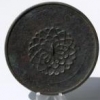




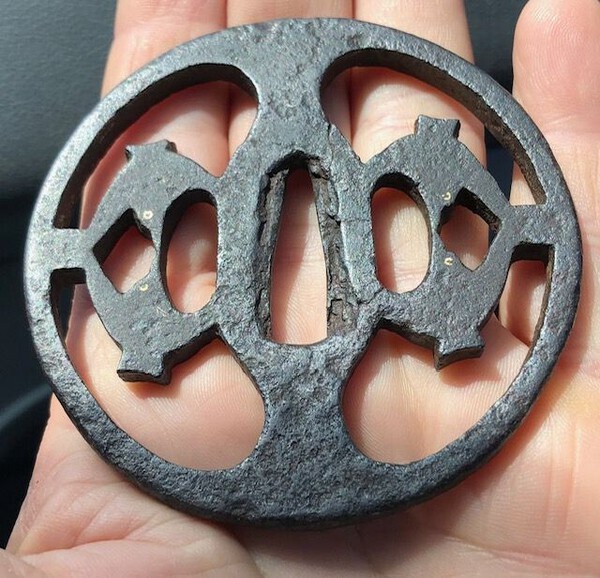






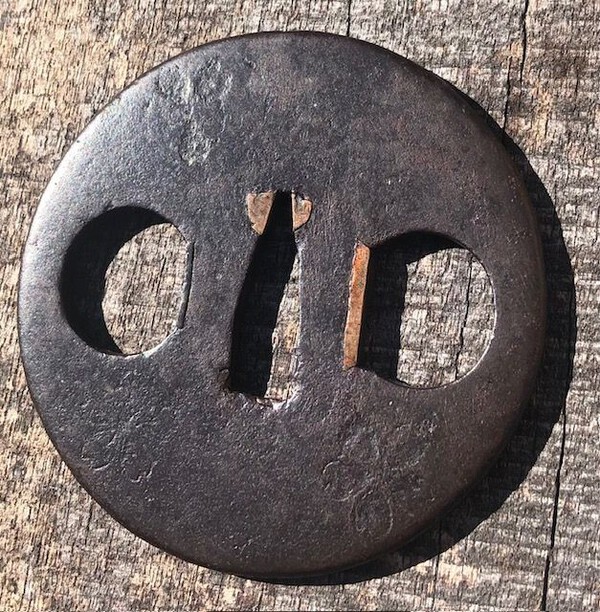





.thumb.jpg.557571310fb6dff5df08df95cabe51e0.jpg)



.thumb.jpg.9a31b5c3b513fbafe876bab4f9aad1a8.jpg)

